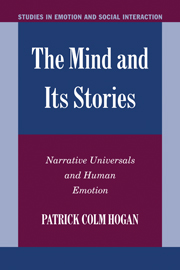Book contents
- Frontmatter
- Contents
- Acknowledgments
- The Mind and Its Stories
- Introduction: Studying Narrative, Studying Emotion
- 1 Literary Universals
- 2 Emotion and Suggestion: Lexical Processes in Literary Experience
- 3 Four Hypotheses on Emotion and Narrative
- 4 Writing Beyond the Ending: A Problem of Narrative, Empathy, and Ethics
- 5 Extending the Theory: Emotion Prototypes, Narrative Junctures, and Lyric Poetry
- 6 Testing, Revision, and the Program of Research in Narrative Universals: Ainu Epic and the Plot of Sacrifice
- 7 The Structure of Stories: Some General Principles of Plot
- Afterword: From the Emotional Nature of Narrative to the Narrative Nature of Emotion
- Works Cited
- Index
- Titles in the series
5 - Extending the Theory: Emotion Prototypes, Narrative Junctures, and Lyric Poetry
Published online by Cambridge University Press: 11 July 2009
- Frontmatter
- Contents
- Acknowledgments
- The Mind and Its Stories
- Introduction: Studying Narrative, Studying Emotion
- 1 Literary Universals
- 2 Emotion and Suggestion: Lexical Processes in Literary Experience
- 3 Four Hypotheses on Emotion and Narrative
- 4 Writing Beyond the Ending: A Problem of Narrative, Empathy, and Ethics
- 5 Extending the Theory: Emotion Prototypes, Narrative Junctures, and Lyric Poetry
- 6 Testing, Revision, and the Program of Research in Narrative Universals: Ainu Epic and the Plot of Sacrifice
- 7 The Structure of Stories: Some General Principles of Plot
- Afterword: From the Emotional Nature of Narrative to the Narrative Nature of Emotion
- Works Cited
- Index
- Titles in the series
Summary
The literary importance of the emotive and plot structures and principles discussed in the preceding chapters would appear to be confined to explicitly narrative literature – stories, plays, novels, epics. This is hardly a narrow scope. Narrative literature is vast and there is no reason to expect that an account of explicit narratives could be extended to another area of literature. On the other hand, such an extension would give greater force to the initial account and would further its research program in valuable ways. In the following pages, I shall argue that we can in fact extend these structures and principles to lyric poetry. Indeed, in the conclusion to this chapter, I shall argue that the preceding theory can be extended even beyond literature to aspects of our ordinary lives, such as religious belief, and that the narrative study of lyric poetry helps us to see this.
LYRIC POEMS AS IMPLICIT PLOTS: THE NARRATIVE HYPOTHESIS
More exactly, we tend to think of narrative and nonnarrative verbal art as sharply distinct. However, the structure of plots and the universal features of lyric poetry indicate that this is a misconception. In particular, lyric poems are commonly set off against narrative, opposed to it. For example, one standard handbook defines a lyric poem as “A poem, brief and discontinuous, emphasizing sound and pictoral imagery rather than narrative” (Frye, Baker, and Perkins 268). However, I shall argue that lyric poems are not separate from narrative.
- Type
- Chapter
- Information
- The Mind and its StoriesNarrative Universals and Human Emotion, pp. 152 - 171Publisher: Cambridge University PressPrint publication year: 2003



